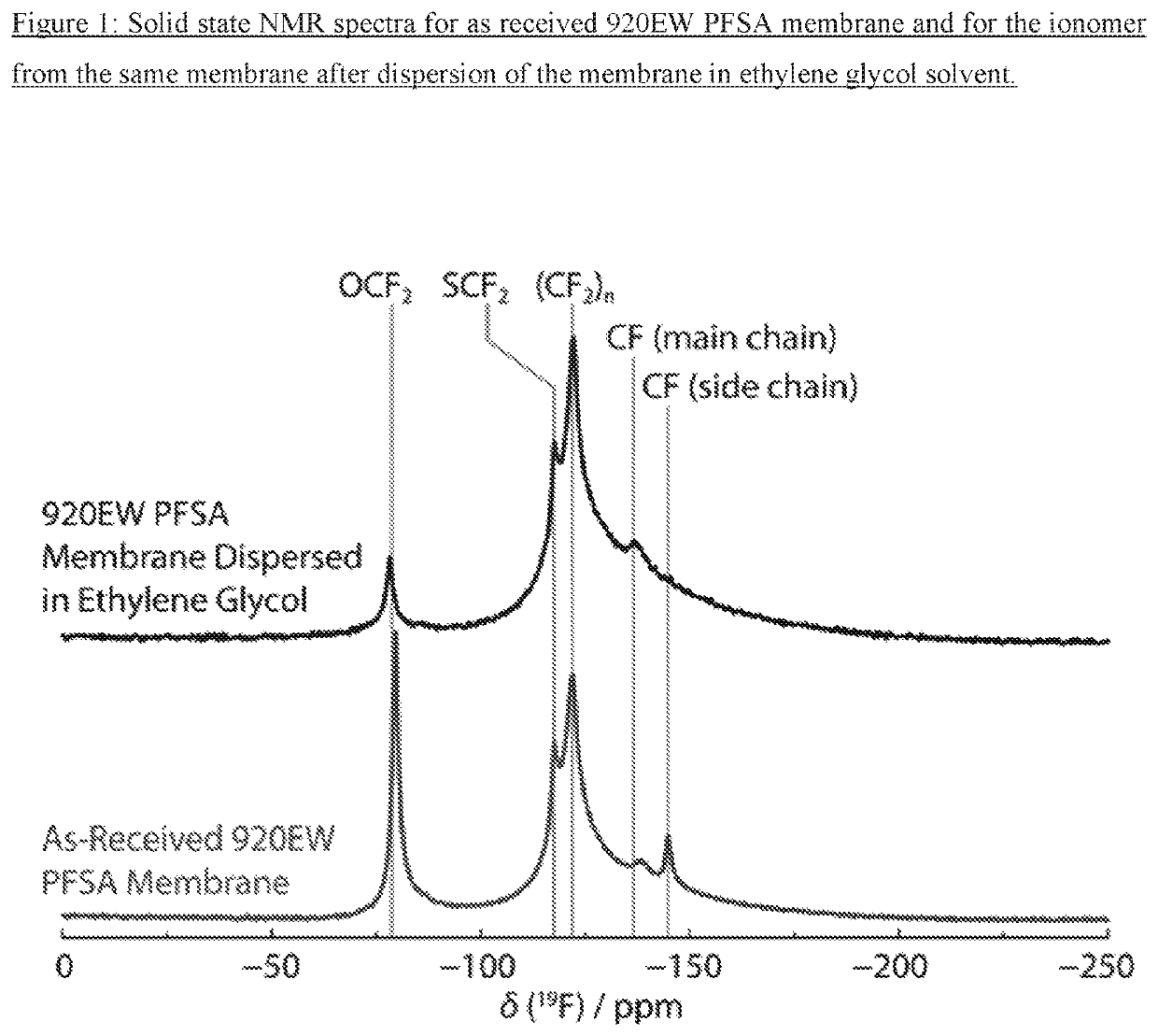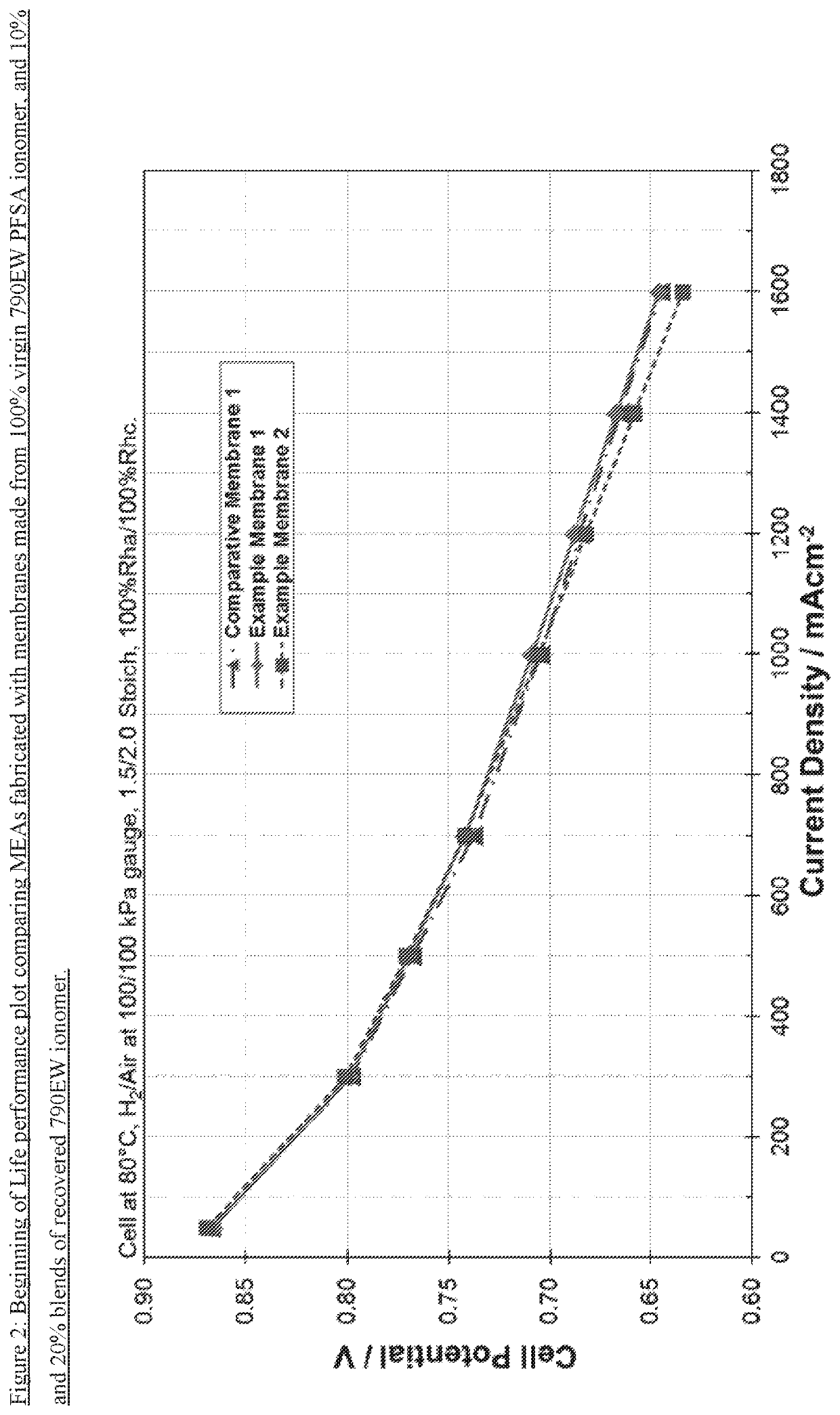Process for the recovery of ionomer
a technology of ionomer and recovery process, which is applied in the field of recovery process of ionomer, can solve the problems of increasing the cost of precious metal catalysts and proton conducting membrane components, increasing the cost of key components of mea, and increasing the tightness of the law requiring car companies to recycle or recover an increasing amount of original vehicle weight, so as to achieve the effect of reducing some cost issues
- Summary
- Abstract
- Description
- Claims
- Application Information
AI Technical Summary
Benefits of technology
Problems solved by technology
Method used
Image
Examples
example 1
Membrane Dispersion
[0111]A sample of an unused e-PTFE reinforced 790 EW PFSA membrane (thickness 17 μm) was placed in 20 cm3 of a range of aliphatic diol solvents for 5 hours and the mixture heated to varying temperatures, essentially at zero applied pressure. The initial mass and the final mass of the remaining solid material were measured and the percentage membrane dispersion calculated. The results are shown in Table 1.
[0112]
TABLE 1Initial Final mass ofmass ofMembraneTemper-membranemembranedispersion intoaturesamplesamplesolutionSolvent(° C.)(mg)(mg)(%)Ethylene glycol12020480Propylene glycol90203851,2-butanediol90214811,3-propanediol90201525120205751,4-butanediol902018101,5-pentanediol9020133512020385
[0113]It should be noted that the PFSA membranes comprise an e-PTFE reinforcement which does not dissolve in the solvent and which accounts for around 15% by weight of the original membrane sample. Thus this limits the maximum possible dispersion in these trials to around 85%. It ca...
example 2
Effect of Temperature and Time on Dispersion of Membrane
[0114]Samples of an unused e-PTFE-reinforced PFSA membrane (30 μm thickness, 790 EW) were weighed. The initial mass includes the weight of the e-PTFE reinforcement which accounts for approximately 7% of the total weight of the membrane.
[0115]The samples were placed in 35 cm3 of ethylene glycol solvent and heated to temperatures of 90° C., 120° C. and 150° C. for times varying from 1-5 hours. The final mass of the remaining solid material was measured and the percentage membrane dispersion into solution calculated.
[0116]The results are shown in Table 2.
[0117]
TABLE 2MembraneTemper-Dur-Initial Final Mass dispersionatureationmassmasslossinto solution(° C.)(hours)(g)(g)(g)(%)9010.16640.04510.12137320.17400.03440.13968030.21270.01800.19479240.18780.01780.17009112010.18480.01550.16939220.19140.01350.17799330.19310.01720.17599140.11770.01260.10518950.19420.01710.17719115010.18570.01510.17069220.18800.01490.17319230.18700.01480.17229240...
example 3
Structural Analysis of Dispersed Ionomer
[0119]19 F solid state NMR spectroscopy was carried out on a sample of an “as received” 920 EW PFSA membrane and on a sample of the ionomer dispersed in ethylene glycol solvent following dispersion tests performed on the membrane as described in the inventive process. A sample of the membrane (11.4 g) was heated in ethylene glycol (60 cm3) at 150° C. for 6 hours. The two spectra are shown in FIG. 1. The results indicate the presence of SCF2, (CF2)n and main CF groups in similar ratios and demonstrate that the dispersion process of the invention to recover the ionomer from the original membrane has not significantly affected the chemical structure of the PFSA ionomer.
PUM
| Property | Measurement | Unit |
|---|---|---|
| temperature | aaaaa | aaaaa |
| temperature | aaaaa | aaaaa |
| temperature | aaaaa | aaaaa |
Abstract
Description
Claims
Application Information
 Login to View More
Login to View More - R&D
- Intellectual Property
- Life Sciences
- Materials
- Tech Scout
- Unparalleled Data Quality
- Higher Quality Content
- 60% Fewer Hallucinations
Browse by: Latest US Patents, China's latest patents, Technical Efficacy Thesaurus, Application Domain, Technology Topic, Popular Technical Reports.
© 2025 PatSnap. All rights reserved.Legal|Privacy policy|Modern Slavery Act Transparency Statement|Sitemap|About US| Contact US: help@patsnap.com


